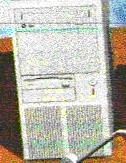 Hard Drive
The hard drive is the
primary device that your computer uses to store information. A storage
device holds information. Most computers come with one hard drive
labeled the C: drive. The amount of information a hard drive can
store is measured in bytes. A hard drive with the capacity of at
least 20 GB (gigabytes) is recommended. However, you should get the
largest hard drive that you can afford.
The Hard Drive is located inside the main system
unit.
Floppy Drive
The floppy drive stores
and retrieves information on a floppy disk. A storage device holds
information. A computer may have one or two floppy drives.
If it has one floppy drive, the drive is called the A: drive. If
it has two floppy drives, the second is called the B: drive. Most
floppy drives use 3.5 inch floppy disks. Some older computers may
have a 5.25 inch floppy drive. It is recommended that a high-density
(1.44MB) 3.5 inch floppy drive be used.
The Floppy Drive is located inside the main
system unit.
CD-ROM Drive
The CD-ROM (Compact-Disc
Read Only Memory) drive is a storage device that your computer uses to
read information stored on compact discs. A storage device holds
information. A CD-ROM is the same type of disc you buy at a music
store. The storage capacity of a CD-ROM disc is greater than 400
floppy disks. CD-ROM discs are used to store programs, large images,
audio, video, and multimedia presentations. The speed of a CD-ROM
drive determines how fast the stored information is transferred from disc
to computer. It is recommended that your CD-ROM drive be at least
52X.
The CD-ROM Drive is located inside the main
system unit.
Hard Drive
The hard drive is the
primary device that your computer uses to store information. A storage
device holds information. Most computers come with one hard drive
labeled the C: drive. The amount of information a hard drive can
store is measured in bytes. A hard drive with the capacity of at
least 20 GB (gigabytes) is recommended. However, you should get the
largest hard drive that you can afford.
The Hard Drive is located inside the main system
unit.
Floppy Drive
The floppy drive stores
and retrieves information on a floppy disk. A storage device holds
information. A computer may have one or two floppy drives.
If it has one floppy drive, the drive is called the A: drive. If
it has two floppy drives, the second is called the B: drive. Most
floppy drives use 3.5 inch floppy disks. Some older computers may
have a 5.25 inch floppy drive. It is recommended that a high-density
(1.44MB) 3.5 inch floppy drive be used.
The Floppy Drive is located inside the main
system unit.
CD-ROM Drive
The CD-ROM (Compact-Disc
Read Only Memory) drive is a storage device that your computer uses to
read information stored on compact discs. A storage device holds
information. A CD-ROM is the same type of disc you buy at a music
store. The storage capacity of a CD-ROM disc is greater than 400
floppy disks. CD-ROM discs are used to store programs, large images,
audio, video, and multimedia presentations. The speed of a CD-ROM
drive determines how fast the stored information is transferred from disc
to computer. It is recommended that your CD-ROM drive be at least
52X.
The CD-ROM Drive is located inside the main
system unit.
 Tape Drive
The tape drive is a
storage device that your computer uses to copy files from the computer
onto tape cartridges. A storage device holds information. These
drives are also known as tape backups. Tape drives can be used to
backup data (extra copies in case of emergency), archive data (rarely used
files), and transfer data (file sharing).
Tape Drive
The tape drive is a
storage device that your computer uses to copy files from the computer
onto tape cartridges. A storage device holds information. These
drives are also known as tape backups. Tape drives can be used to
backup data (extra copies in case of emergency), archive data (rarely used
files), and transfer data (file sharing).

BACK
HOME
